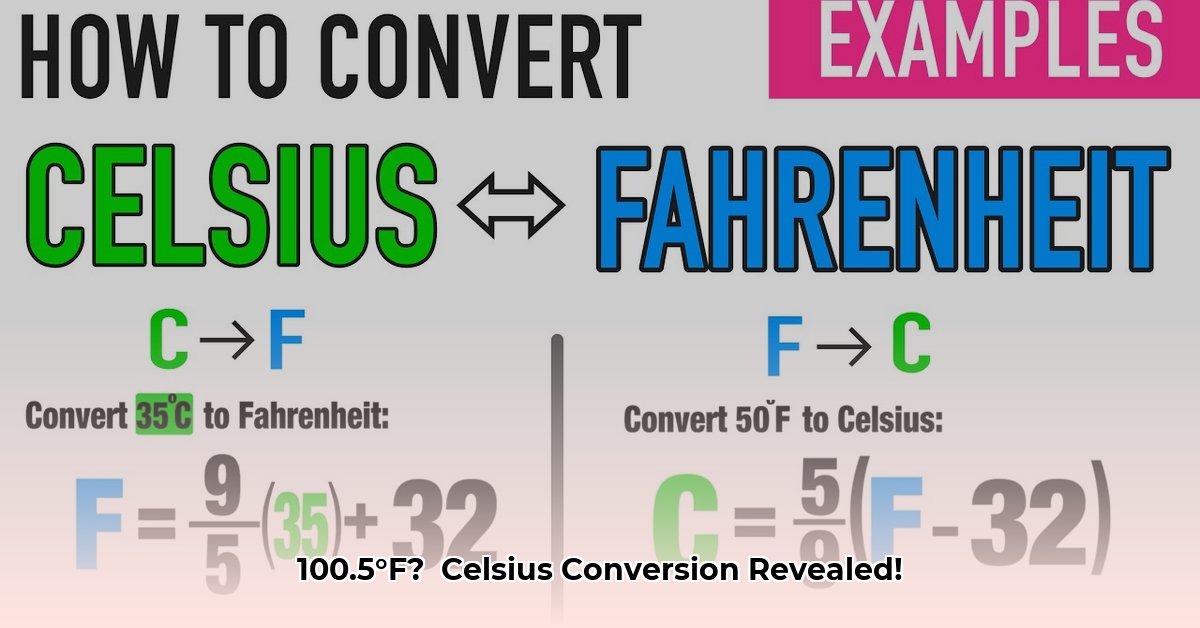Converting 100.5°F to Celsius: A Quick Guide
100.5°F is approximately 38.1°C.
Understanding the Conversion
The Formula: The Key to Temperature Conversion
The conversion from Fahrenheit (°F) to Celsius (°C) relies on this formula:
°C = (5/9) * (°F – 32)
This formula adjusts for the different freezing points of water on each scale (32°F and 0°C).
Calculation Breakdown: Step-by-Step Conversion
Let’s apply the formula to 100.5°F:
- Subtract 32: 100.5 – 32 = 68.5
- Multiply by 5/9: 68.5 * (5/9) ≈ 38.06
Rounding to one decimal place gives us 38.1°C.
Fahrenheit and Celsius: A Comparison
- Fahrenheit: Primarily used in the United States, with water freezing at 32°F and boiling at 212°F.
- Celsius: Used globally and in science, with water freezing at 0°C and boiling at 100°C.
What 100.5°F Feels Like
100.5°F is generally considered a low-grade fever in humans. It’s a warm temperature, comparable to a warm bath or a hot summer day.
Nearby Conversions: A Quick Reference
| Fahrenheit (°F) | Celsius (°C) |
|---|---|
| 100°F | 37.8°C |
| 100.5°F | 38.1°C |
| 101°F | 38.3°C |
| 101.5°F | 38.6°C |
| 102°F | 38.9°C |
Beyond Fahrenheit and Celsius: The Kelvin Scale
While less common for everyday use, the Kelvin scale is essential in scientific contexts. It starts at absolute zero (-273.15°C or -459.67°F), the theoretically lowest possible temperature.
The Nuances of Temperature
While the conversion formula provides a precise calculation, the actual perception of temperature can be influenced by factors like humidity. A humid 38°C day can feel significantly hotter than a dry 38°C day. This is why meteorologists often use the “heat index,” which considers humidity’s impact.
Furthermore, while we generally use standard values for water’s boiling point (100°C or 212°F), this can vary slightly with air pressure. At higher altitudes, where air pressure is lower, water boils at a lower temperature.
Ongoing Research: Refining Our Understanding
Ongoing research continually refines our understanding of temperature measurement. Current methods are very accurate for everyday applications, but there’s always room for improvement. Future studies may subtly refine established conversion factors as our technology advances. Some experts suggest that the current formula may eventually be adjusted by a tiny factor, although this would likely be negligible for practical purposes.
Additionally, research into areas like nanoscale thermodynamics and quantum phenomena is expanding our understanding of temperature at extreme scales, where traditional concepts may not fully apply. These studies may one day lead to new ways of defining and measuring temperature.
By understanding the conversion process, comparing different scales, and acknowledging the nuances of temperature, you can confidently interpret and apply temperature readings in various contexts.
- Weight Loss Supplements That Work and Those That Dont - October 31, 2025
- Male Eating Disorders Often Missed but Increasingly Prevalent - October 29, 2025
- Males With Anorexia Nervosa Have Distinct Symptoms and Treatment Needs - October 28, 2025










